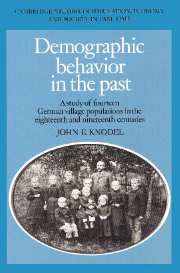 Demographic Behavior in the Past
Demographic Behavior in the Past Book contents
- Frontmatter
- Contents
- List of tables
- List of figures
- Acknowledgements
- PART I INTRODUCTION
- PART II MORTALITY
- PART III FAMILY FORMATION
- PART IV MARITAL REPRODUCTION
- PART V INTERRELATIONSHIPS IN DEMOGRAPHIC BEHAVIOR
- PART VI CONCLUSION
- Appendices
- A Selection of couples for analysis
- B Assessment of the quality of demographic data contained in German village genealogies
- C Local village conditions
- D The occupational and status classification schemes
- E Calculation of infant and child mortality risks
- F Prevailing infant-feeding patterns
- G Evidence of biases in the determination of legitimization status
- Bibliography
- Index
E - Calculation of infant and child mortality risks
Published online by Cambridge University Press: 04 August 2010
- Frontmatter
- Contents
- List of tables
- List of figures
- Acknowledgements
- PART I INTRODUCTION
- PART II MORTALITY
- PART III FAMILY FORMATION
- PART IV MARITAL REPRODUCTION
- PART V INTERRELATIONSHIPS IN DEMOGRAPHIC BEHAVIOR
- PART VI CONCLUSION
- Appendices
- A Selection of couples for analysis
- B Assessment of the quality of demographic data contained in German village genealogies
- C Local village conditions
- D The occupational and status classification schemes
- E Calculation of infant and child mortality risks
- F Prevailing infant-feeding patterns
- G Evidence of biases in the determination of legitimization status
- Bibliography
- Index
Summary
In all the analyses of infant and child mortality, calculations are limited to locally born children during periods when registration of child deaths are judged to be relatively complete (restrictions 6 and 7 as defined in Appendix A). The reason for limiting mortality analysis to periods of reliable death registration is self-evident. Requiring that the child be born locally helps ensure that the period under observation starts with the birth.
In order to calculate infant and child mortality risks, all children for whom a birth date but no death date was given in the reconstituted families selected from the genealogies for analysis were assumed to survive to at least age 15. Presumably, missing death dates signified that the person left the village and died elsewhere. In effect, the assumption is made that in these cases no child who left the village died before age 15. In most cases this assumption is probably reasonable since the sample includes only families in which at least one parent's death date was known, generally indicating that the family was in the village until the union was broken by death. Moreover, when calculating death risks for analyses including or focusing on mortality risks through ages past infancy, usually only children born to couples whose union ended locally and for whom the date of the end of union is known with certainty are included.
- Type
- Chapter
- Information
- Demographic Behavior in the PastA Study of Fourteen German Village Populations in the Eighteenth and Nineteenth Centuries, pp. 535 - 541Publisher: Cambridge University PressPrint publication year: 1988


